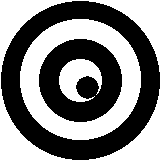The number of figures that are known to have been used at one time or another in the history of the Country Dance is very large; and this means that the number of possible varieties of the Country Dance is practically infinite. For any series of figures, combined in accordance with the theory of the dance and in conformity with the structure of the tune, will constitute a complete figure. With two exceptions, “The Triumph” and “Sir Roger de Coverley”, each of which is invariably danced in its own way and to its own tune, not a single one of the innumerable varieties of the Country Dance has ever been recognised, except perhaps locally, as a fixed and distinct dance.
It should be mentioned that when the Country Dance was performed in the ball-room it was the custom for the leading couple to have the “call”; that is, the privilege of naming the tune and prescribing the figures. It was necessary, therefore, for expert dancers of those days to be proficient not only in the performance of the dance but in the theory as well. For the benefit of those who were unable to make the “call” numerous publications were issued from the 17th century onwards, containing Country Dance airs, together with the descriptions of the figures, though not of the steps, that were to be danced to them. Similar descriptions, but with the names only of the tunes to which they were to be performed, were also often printed on the fly-leaves of pocket books and diaries of the 18th and early 19th centuries. Usually, though not invariably, the name of the dance was derived from that of the tune.
The figures that are now to be explained represent a few only those that are still in use in the country districts. They include, however, all of those which occur in one or other of the dances presently to be described. First, however, it will be necessary to explain the meaning of certain technical terms, symbols, expressions, &c., that will be used in the notation:
- The term “lead” is used when partners move up or down the set with joined hands.
- To “move” is an expression which is applied to individual dancers, or to partners with unlinked hands, when the movement takes place between the lines of the General Set.
- To “cast off” is to turn outwards and proceed without one or other of the lines of the dancers; to “cast up” or “cast down” is to dance up or down outside the General Set.
- Two adjacent couples are said to “cast one” when, at the end of a movement, they exchange positions.
- To “cross hands” the man takes the right and left hands of his partner with his right and left hands respectively, the right hands being uppermost. The hands are sometimes though rarely, crossed behind the backs of the dancers.
In the diagrams the positions of the women are shown, as hitherto, by squares, and those of the men by circles; while the paths of the women are indicated by dotted lines, and those of the men by ordinary lines.
When music diagrams are used to explain the steps, R stands for right foot, L for left foot, and H for hop.
FIGURE 1.
SWING OR SET.
(Eight Bars.)
Partners meet, engage in waltz fashion, and dance around in a small circle between the lines of the General Set. At the beginning of the last bar they disengage, return to places, and bow to each other.
The step varies with the rhythm of the music, and may take any one of the three following forms: (1) The waltz step; (2) the polka step or a modification of it; (3) step and hop on alternate feet.
Country dancers sometimes, though very rarely, substitute for the Swing the more conventional Set or Set-to-partners, a figure which is familiar to all quadrille dancers. This was the invariable custom in the ball-room where the Swing, as above described, was quite unknown.
There was, however, a figure known to fashionable dancers as the Swing, but this was performed in quite another manner; Partners met, joined right hands, turned slowly round from right to left and returned to places.
In the notation the term Swing may be interpreted in any one of these three ways. The first method, which is also the traditional one, will probably be found the most suitable.
FIGURE 2.
FIRST COUPLE SWINGS DOWN THE MIDDLE AND TAKES UP POSITION BELOW THE LAST COUPLE.
(Eight Bars.)
The first couple swings slowly down the middle, while each of the other couples moves up one place. The first couple, on reaching the bottom of the General Set, takes the position just vacated by the last couples (eight bars). This is a progressive figure, and is performed in whole-set dances only.
FIGURE 3.
FIRST COUPLE SWING AND CAST ONE.
(Eight Bars.)
First and second couples swing at the same time, taking care not to obstruct each other. At the end of this figure they exchange positions, the top couple moving down one place, and the second couple moving up one place.
This is a progressive figure.
FIGURE 4.
FIRST COUPLE LEADS DOWN THE MIDDLE AND BACK AGAIN.
(Eight Bars.)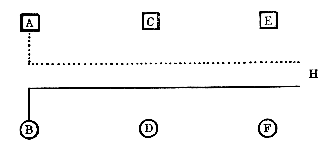
The first woman and the first man, A and B, join and raise left hands and lead down the middle to H (four bars). They then release hands, turn round and, right hand in right hand, lead up to the top. Here they separate, return to places and bow to each other (four bars).
The turn at H is sometimes performed in the following way:- B, with his left hand, raises his partner's left hand above her head, turns her round under it, and then leads her up to the top with crossed hands.
The traditional walking step is generally used in leading down, but in leading up a more lively step is customary.
In a whole-set dance A and B will lead down to the bottom of the General Set, or as far as time will allow; but in a minor-set dance they must be careful not to cause confusion by going more than a few steps at the most beyond the limits of their own minor-set.
FIGURE 5.
THE FIRST COUPLE LEADS DOWN THE MIDDLE AND BACK AGAIN AND CASTS ONE.
(Eight Bars.)
The first couple leads down the middle in the way described in the last figure (four bars). While this movement is in progress the second couple moves up one place. The first couple on reaching the top of the General Set takes the position previously held by the second couple (four bars).
This is a progressive figure.
FIGURE 6.
FIRST MAN AND WOMAN LEAD DOWN THE MIDDLE AND BACK AGAIN AND THROUGH THE TOP COUPLE.
(Eight Bars.)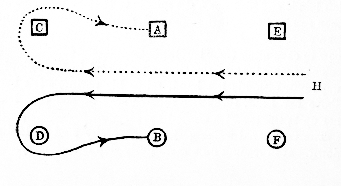
This is a variant of the preceding figure. A and B, on returning up the middle, instead of proceeding at once to the places vacated by the second couple, lead up to the top, release hands and cast off, pass round and outside C and D respectively, and proceed to their new positions as in the last figure (eight bars).
This is a progressive figure.
FIGURE 7.
“STEP AND FETCH HER”, WITH FIRST COUPLE AND SECOND MAN.
(Eight Bars.)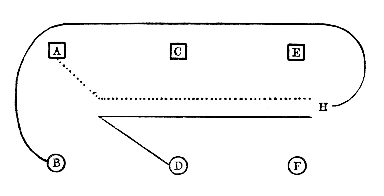
D and A meet and lead down the middle to H. At the same time B crosses over and casts around A, C and E. All three meet at H (four bars).
B now displaces D, crosses hands with A, and leads her up the middle, D, with hang-dog expression following disconsolately. All three return to original places (four bars).
FIGURE 8.
“STEP AND FETCH HER”, WITH SECOND COUPLE AND FIRST MAN.
(Eight Bars.)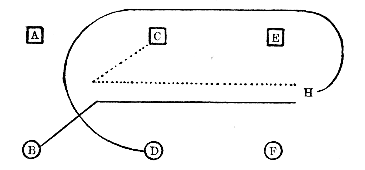
B and C meet and lead down the middle to H, while D crosses over and casts around C and E. All three meet at H (four bars).
D now displaces B, and leads A up the middle, B following behind them in the way described in the last figure. All three return to original places (four bars).
FIGURE 9.
“THE TRIUMPH”, WITH FIRST COUPLE AND SECOND MAN.
(Eight Bars.)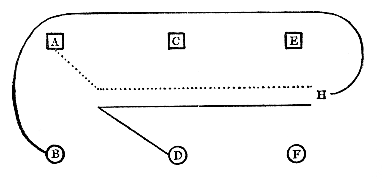
D meets A and leads her down the middle to H. During this movement B crosses over and casts round A, C, and E. All three meet at H (four bars).
D and B stand on the left and right of A respectively.
D and A join left hands, while B and A join right hands. D with his right hand takes the left hand of B.
The two men, B and D, raise their joined hands above A's head and lead her “in triumph" up the middle to the top, where all three separate and return to their proper places (four bars).
FIGURE 10.
“THE TRIUMPH”, WITH SECOND COUPLE AND FIRST MAN.
(Eight Bars.)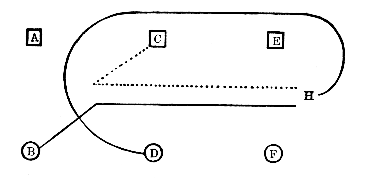
B and C meet and lead down the middle to H. Simultaneously D crosses over and casts round C and E. All three meet at H (four bars).
The two men, B and D, now lead C “in triumph" up the middle as in the last figure (four bars).
FIGURE 11.
HANDS ACROSS WITH FIRST AND SECOND COUPLES.
(Eight Bars.)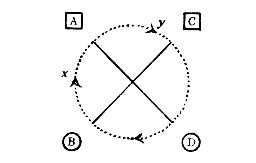
B and C join right hands. D and A do the same. All four dance round in direction x y (four bars).
They then release and change hands, dance round in the reverse direction and return to places (four bars).
A and D have their hands uppermost.
The hands should be held as high as the faces of the performers.
FIGURE 12.
FIRST AND SECOND COUPLES PASS UNDER FOUR TIMES.
(Eight Bars.)
Partners hold a handkerchief or a ribbon between them in their right hands. First and second couples face each other, the first couple looking down and the second couple up the General Set.
The first couple then moves down three short steps, raising right arms and making an arch with the handkerchief. At the same time, the second couple moves up three steps, passing under the arch made by the first couple (two bars).
The second couple now moves down three steps, making an arch, under which the first couple passes up, taking three steps as before (two bars).
This double movement is then repeated, after which the dancers separate and return to places (four bars).
FIGURE 13.
FIRST WOMAN AND SECOND MAN ADVANCE, BOW, TURN ROUND, AND SWING.
(Eight Bars.)
The first woman and the second man advance a step or two towards each other. The woman curtseys and the man bows, after which they both turn round slowly without moving from their respective positions (four bars).
They advance, meet, swing and return to places (four bars).
The first half of this movement must be made with great deliberation.
FIGURE 14.
FIRST MAN AND SECOND WOMAN ADVANCE, BOW, TURN ROUND, AND SWING.
(Eight Bars.)
The first man and the second woman advance a step or two towards each other. The man bows, the woman curtseys, and then each turns round slowly without moving from position (four bars).
They meet, swing and return to places (four bars).
FIGURE 15.
FIGURE EIGHT BY FIRST MAN.
(Eight Bars.)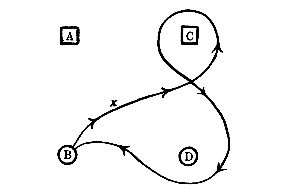
B advances along line x, passes round the right of C, then round the left of D and back to position (eight bars).
FIGURE 16.
FIGURE EIGHT BY FIRST WOMAN.
(Eight Bars.)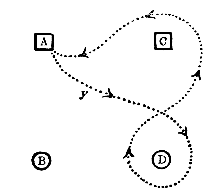
A advances along line y, passes round the left of D, then round the right of C and back to position (eight bars).
FIGURE 17.
FIGURE EIGHT BY FIRST MAN AND FIRST WOMAN.
(Eight Bars.)
The two preceding figures are performed simultaneously by first man and first woman. The man must be careful to allow the woman to pass in front of him.
FIGURE 18.
FIRST COUPLE SEPARATES AND CASTS OFF, FOLLOWED BY ALL THE COUPLES EXCEPT THE LAST ONE. PARTNERS
MEET BELOW THE LAST COUPLE, PASS SUCCESSIVELY UNDER AN ARCH MADE BY LAST COUPLES, LEAD
UP AND RETURN TO THEIR RESPECTIVE PLACES.
(Eight Bars.)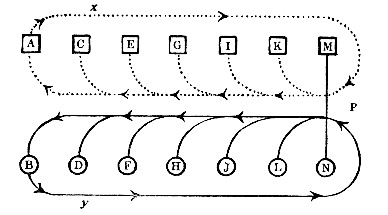
A casts off along doted line x, followed by C, E, G, &c.
B casts off along line y, followed by D, F, H, &c.
A and B meet at P, join right hands, pass under an arch made by M and N, and lead up the middle to their proper places, followed by all the other couples.
C, E, G, &c., and D, F, H, &c., before casting off, proceed, not necessarily to the top of the General Set, but as far as the time of the music will allow.
FIGURE 19.
FIRST COUPLE VISITS SECOND WOMAN AND SECOND MAN.
(Eight Bars.)
First couple, with joined hands, moves down and faces second woman. The two women curtsey while the man bows (four bars).
The first couple turns and faces second man, with whom similar courtesies are exchanged. They then separate and return to places (four bars).
FIGURE 20.
FIRST COUPLE LINKS ARMS AND SWINGS ROUND.
(Eight Bars.)
Partners advance and meet. They link right or left arms according to instructions, and facing in opposite directions, swing round, separate and return to places (four bars).
FIGURE 21.
FIRST MAN AND FIRST WOMAN MOVE DOWN THE MIDDLE AND CAST UP THROUGH THE THIRD COUPLE.
(Eight Bars.)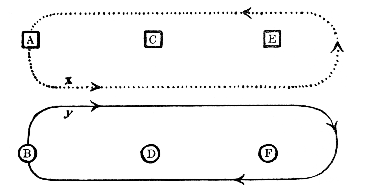
A moves down the middle along the dotted line x (four bars), casts off round the third woman E and returns to position (four bars).
Simultaneously, B moves down the middle along the line y (four bars), casts off round the third man F and returns to position as shown in the diagram (four bars).
FIGURE 22.
FIRST AND SECOND COUPLES CROSS OVER, TURN ROUND AND CROSS BACK AGAIN.
(Eight Bars.)
First and second couples cross over, each man passing on the left of his partner (two bars).
All four dancers turn round and face each other (two bars).
The movement is then repeated in reverse, the men passing on the right of their partners (four bars). This brings all four dancers back to places.
FIGURE 23.
MEN AND WOMEN ADVANCE, RETIRE, AND CROSS OVER; AND THEN REPEAT MOVEMENT IN REVERSE.
(Sixteen Bars.)
Men and women advance, meet and bow (two bars). They then retire to places (two bars).
Men cross over to women's side, and women cross over to men's side, each man passing on the left of his partner (two bars).
All turn round and face partners (two bars).
These movements are then repeated in reverse, the men passing on the right of their partners. This brings all the dancers back to places (eight bars).
Sometimes the men link arms and the women join hands in advancing and retiring.
FIGURE 24.
FIRST COUPLE, WITH CROSSED HANDS, CASTS OFF AND LEADS UP THE MIDDLE TO POSITION, FOLLOWED
BY ALL THE OTHER COUPLES.
(Eight Bars.)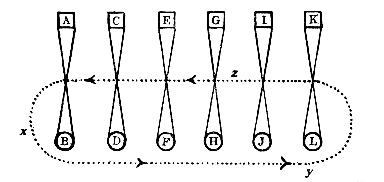
All partners cross hands and follow A and B, who cast off in the line x y, lead up the middle along the line z, and return to position (eight bars).
FIGURE 25.
FIRST MAN AND FIRST WOMAN CAST OFF, PASS THROUGH THE THIRD COUPLE, LEAD UP THE
MIDDLE AND FACE THE SECOND COUPLE.
(Eight Bars.)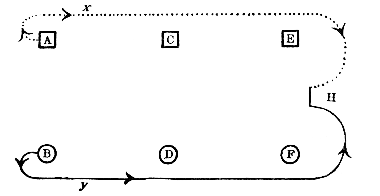
A casts off in line x and B casts off in line y. They meet at H (four bars). During this movement, C and D move up into the places just vacated by A and B.
A and B now lead up the middle (four bars), C and D with joined hands meeting and facing
them at the top, thus:-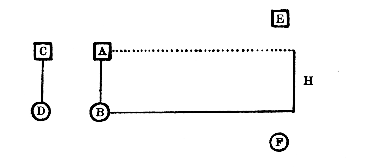
FIGURE 26.
SECOND AND FIRST COUPLES, FACE TO FACE, MOVE DOWN THE MIDDLE AND UP AGAIN; THE FIRST
COUPLE PASSES UNDER.
(Eight Bars.)
C and D face A and B, as shown in the last diagram of the preceding figure. All four move down the middle to H, C and D forwards, C and D backwards. When they have nearly reached the top, C and D raise their joined hands, under which A and B pass. All four return to their original places (four bars).
Partners join right hands throughout this figure.
FIGURE 27.
HANDS THREE ON THE WOMEN'S SIDE; FIRST WOMAN PASSES UNDER.
(Eight Bars.)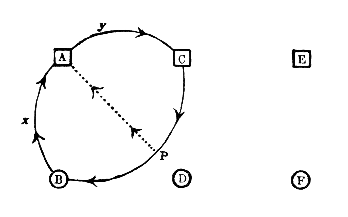
A, B and C join hands and dance once round in a ring in the direction x y (four bars).
They continue dancing in the same direction for another half circle, when A will be at P (two bars).
B and C then raise their joined hands, under which A then passes to her place (two bars).
It is important that the passing under the arch should occur exactly on the first beat of the seventh bar of the music.
FIGURE 28.
HANDS THREE ON THE MEN'S SIDE; FIRST MAN PASSES UNDER.
(Eight Bars.)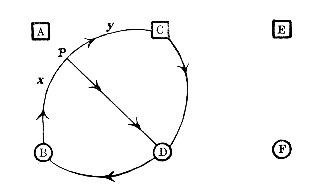
B, C and D join hands and dance once round in a ring in the direction x y (four bars).
They continue dancing in the same direction for another half circle, when D will be at P (two bars).
B and C then raise their joined hands, under which D passes to his place (two bars).
This figure follows the preceding one without pause.
FIGURE 29.
FIRST COUPLE TURNS; SECOND WOMAN PASSES UNDER TO PLACE.
(Eight Bars.)
First man and first woman join and raise their right hands and dance round in a small circle between the lines of the General Set. On the first note of the seventh bar of the music they must be exactly opposite the second woman. The latter quickly passes under the arch to the place just vacated by the first woman (eight bars).
This is a progressive figure.
FIGURE 30.
FIRST COUPLE TURNS; SECOND MAN PASSES UNDER TO PLACE.
(Eight Bars.)
First man and first woman continue to dance round in the way described in the last figure. On the first note of the seventh bar the second man passes quickly under the arch and takes the place previously occupied by the first man.
First man and first woman return to places just vacated by second man and second woman (eight bars).
This figure, which is a progressive one, follows upon the preceding one without pause.
FIGURE 31.
THE FIRST WOMAN MOVES DOWN AND BACK, AND CASTS DOWN AND BACK; WHILE THE FIRST MAN CASTS
DOWN AND BACK, AND MOVES DOWN AND BACK.
(Sixteen Bars.)
The first woman A moves down the line x as far as the third woman E (four bars) and then moves backwards to the top (four bars). At H she raises both arms above her head, turns completely round from left to right, casts down in line y as far as E (four bars), and then moves backwards to her place (four bars).
Simultaneously, the first man B casts down in line s as far as third man F (four bars), and then moves backwards to the top (four bars). At P he raises both arms above his head, turns round completely from left to right, moves down the middle along the line n as far as F (four bars), and then returns backwards to position (four bars).
FIGURE 32.
HANDS FOUR WITH FIRST AND SECOND COUPLES.
(Eight Bars.)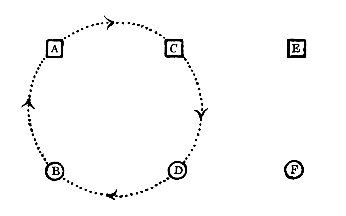
A, B, C and D join hands and dance round in a ring from left to right (four bars).
They then repeat the movement in the reverse direction, separate and return to places (four bars).
[imply, but not what I interpret his text to say!]
FIGURE 33.
THREE MEET.
(Eight Bars.)
First, second and third men link arms. First, second and third women do the same.
The men and women, taking two short steps to each bar, advance towards each other till they meet (two bars).
They then move backwards and return to places (two bars).
This double movement is then repeated (four bars).
FIGURE 34.
DOUBLE CHANGE SIDES WITH FIRST AND SECOND COUPLES.
(Eight Bars.)
First and second women join right hands, cross over to the men’s side (two bars) and retire backwards to places (two bars).
Simultaneously, first and second men cross over to women’s side, passing on either side of the two women, and retire backwards to places (four bars).
This double movement is then repeated, the men joining right hands and passing between the women (four bars).
Page transcribed by Hugh Stewart
